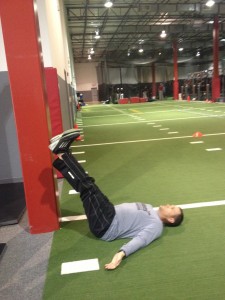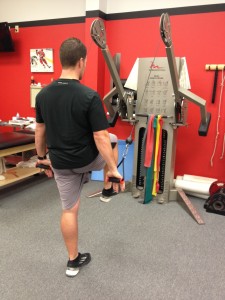Brian Schiff’s Blog
Injury Prevention, Sports Rehab & Performance Training Expert
This exercise is an excellent way to increase hip disassociation and more specifically hamstring flexibility. Foam rolling and/or myofascial compression therapy prior to stretching may further enhance range of motion. This exercise can be used with runners and clients struggling with tendonitis, IT band issues and patellofemoral pain. It is also helpful in eliminating asymmetry that appears on the active straight leg raise on the FMS.
This exercise can be used as part of a mobility workout, warm-up, regeneration day or at the end of a workout. Remember that maximally dorsiflexing the foot will increase dural tension and place more stretch across the back of the knee. So, relaxing the foot (or placing the rope more along the mid foot) will reduce this tension and allow for a more concentrated stretch in the hamstring. For clients with a history of sciatica, I would suggest avoiding the stretch with the foot in full dorsiflexion as a general precaution.
The tensor fascia lata (TFL) is a problematic muscle for many clients. In many cases, it is synergistically dominant over the gluteus medius and often contributes to tightness associated with the IT band. Its actions are primarily hip flexion and abduction, and it tends to be tight in many runners and athletes I see. Performing targeted soft tissue mobilization can help resolve myofascial tightness as well as promote better activation and preferential recruitment of the gluteus medius.
Many people argue the effectiveness of foam rolling the IT band itself. While I am not inclined to ignore it altogether, I do believe that foam rolling probably has a far greater impact on the length/tension of the soft tissue beneath and associated with the IT band (e.g. glutes, quads, hamstrings and TFL). The TFL is often full of trigger points.
Below is a video I created for my Functionally Fit column for PFP Magazine. Employing some routine soft tissue mobilization will help reduce hip flexor tightness and help reset the neuromuscular system and set the stage for enhancing preferential gluteus medius activation during training exercises.
This is the fourth corrective exercise I have featured in my “Functionally Fit” online column for Personal Fitness Professional Magazine. All of the correctives are based on screening assessments from the FMS.
The active straight leg raise (ASLR) assessment (as part of the FMS) is an essential part of any assessment I do on my athletes and runners. It provides a great look at a client’s ability to stabilize their spine/pelvis and we observe hip separation with one hip moving into flexion and the other fixed hip moving into greater relative extension.
Why does hip disassociation matter? Simply put, a lack of ideal separation can negatively impact step and/or stride length, reduce propulsion and create other compensations that increase energy expenditure and reduce overall running form. Some deviations that may occur include hip drop, increased rotation or circumduction of the swing leg, excessive torso rotation, increased knee flexion and diminished stride length to name a few.

Execution: Lie on your back. Using a doorway, place one leg against the doorway in a position that allows you to keep the lumbar spine flat while the other leg is extended and on the floor. Next, flex the down hip to the height of the other fixed leg extending the knees. This leg will remain unsupported. Now, point the toes of the unsupported leg and reach out toward the ceiling. Slowly lower the leg to the floor or the lowest point where you can still maintain a neutral lumbar spine (a bolster may be placed beneath the leg if needed). Perform 10 repetitions and repeat 2-3 sets on each side.
Progress the activity by lowering the leg further and/or sliding closer to the doorway to increase the hip flexion and total hip separation. Do not allow the lumbar spine to extend as this is a common compensatory motion for limited mobility in the iliopsoas.


Application: This activity will improve active mobility of flexed hip as well as promote continuous core stability and available hip extension of the opposite hip. It challenges the client’s ability to disassociate the lower extremities while maintaining stability in the pelvis and core. Keep in mind it is more than just a hamstring flexibility activity as it also addresses static (pelvis/spine) and dynamic (hip) stability in asymmetrical hip separation pattern.
This separation pattern is essential for optimal running mechanics. Poor hip disassociation can lead to asymmetrical or bilateral movement flaws, thereby reducing performance and leading to compensatory motion with an elevated risk for injury. This simple technique can be done daily to enhance hip mobility and pelvic/hip stability.
This post is the third corrective exercise in a series I am doing for Personal Fitness Professional Magazine in my online column titled “Functionally Fit.” To read more online exercise tips, visit www.fit-pro.com.
The hurdle step assessment (as part of the FMS) is designed to challenge the body’s proper stepping and stride mechanics as well as stability & control in single leg stance. The step leg must perform ankle DF and hip/knee flexion while core stability must be present in single leg stance.

Limited hip mobility and/or poor hip and core stability restricts natural movement and leads to compensatory motion often in the form of unwanted hip rotation, hip hiking, trunk sway in the frontal and sagittal plane. A common corrective exercise prescribed to improve core stability is a standing march (single leg stance) with straight arm pulling to engage the core.
Execution: Begin standing with the feet together while holding the cable handles with the palms down. Select a weight that provides ample enough resistance to maintain isometric shoulder extension for 30-60 seconds. Be careful not to select too little or too much weight as this will disrupt the execution of the exercise.
Next, pull the arms down toward the side and hold in that position. Maintaining an erect posture, slowly lift the left leg up (ankle dorsiflexion with knee and hip flexion) and pause for 2-3 seconds. Move the unsupported leg back to the start position but keep the arms actively extended. Repeat this sequence for 10 times on the left leg. Rest for 30-60 seconds and then repeat on the other leg. Perform 2 sets.

Additional notes: I tend to focus on unilateral consecutive repetitions (as described above) especially if there is a 2/1 asymmetry with the hurdle step. As the asymmetry is resolving, I will progress to a reciprocal pattern as this is more natural in life/sport. If a cable column is unavailable, alternate methods include using a suspension training apparatus or resistance tubing anchored high enough to accomplish the same upper body isometric pulling.
Application: Poor hip stability and control in single leg stance is a common cause of overuse injuries in runners and contributes to increased risk for anterior knee pain and ACL injuries. Keep in mind that poor performance on the hurdle step movement can be related to weak hip flexors on the stepping leg, tight hip flexors on the stance leg, diminished hip stability and poor balance.
It is critical to assess the whole movement prior to assuming that there is just one problem or weak link in the kinetic chain. Restoring symmetric, optimal stepping patterns will promote proper hip disassociation, as well as training the body to synergistically activate core and hip musculature to demonstrate optimal single leg stability in unilateral stance.
This is the second installment of corrective “go-to” exercises I am highlighting here and in my online column for PFP magazine. Click here to read the post on resisted overhead squats. The in-line lunge allows for the observer to pick up flaws or asymmetry by placing the body in a narrow stance with a wide stride to assess hip, knee, ankle and foot mobility and stability of the client. It places the upper and lower extremities in alternate asymmetrical patterns.
Limited mobility or hip disassociation will produce movement dysfunction with the in-line lunge (see picture below for how it is assessed during the FMS).

A common corrective exercise prescribed to improve mobility is the leg lock bridge.
Execution: Begin in supine flexing one leg up to the chest. Hold the flexed leg against the chest while keeping the extended (down) leg in line with the center of the body and the knee flexed. A small ball (pictured below), pillow or towel roll may be placed between the thigh and chest for tactile feedback regarding the lock position.
Next, push down through the extended leg on the floor to elevate the hips off the ground into a bridge. The height of the bridge should be limited to the point where contact can be maintained between the thigh of the flexed hip and the chest keeping the extended hip/thigh in the in-line position. Perform 2-3 sets of 10-15 repetitions.

Application: The ability to stride in a lunge position without forward trunk lean during the in-line lunge can be inhibited by tight hip flexors. Soft tissue work and stretching is certainly helpful, but this active mobility exercise will improve reciprocal movement and facilitate hip disassociation. It is a great exercise to include as part of your corrective exercise series and/or movement and pillar prep work with your clients.
If clients struggle or experience hamstring cramping, consider adding a small step beneath the foot of the extended leg to increase the hip flexion starting position. Modifications and adjustments to sets, repetitions and distance between the flexed thigh and chest as well as the extended foot and ground should be considered with exercise prescription.

